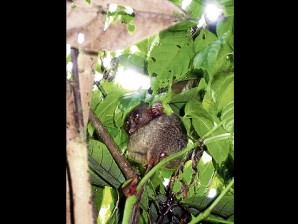Tarsier colonies found in 2 Mindanao Villages
DAVAO CITY—Tarsier colonies have been discovered in two villages in Southern Mindanao, exciting environmental officials who had always thought the tiny primate could not survive outside Bohol.
Joselin Marcus Fragada, director of the Department of Environment and Natural Resources (DENR) in Southern Mindanao, said the discovery had effectively overturned the general belief that the haplorrine (dry-nosed) primates thrive only in Bohol.
A few tarsiers can be found outside Bohol, but the discovery of whole colonies in Southern Mindanao is definitely exciting news for conservationists.
Fragada said large tarsier colonies were found in Barangay Bobon in Mati, Davao Oriental, and Barangay Suaon in Kapalong, Davao del Norte.
“It has been confirmed,” he said.
Tarsiers have been occasionally seen in Sarangani province and in South Cotabato and in the mountainous parts of North Cotabato. But environmental officials have dismissed the tarsier population in those provinces as insignificant.
But in the two Southern Mindanao provinces, Fragada said the tarsier population was enough to make the Protected Areas and Wildlife Division (PAWD) to plan a population count.
He said in Kapalong area, the PAWD would conduct the assessment and population count with the nongovernmental group Davao Speleological and Conservation Society (DSpeCS).
“They will soon start the population count to serve as basis of the management plan to protect the threatened species,” Fragada said.
Smallest primate
The Philippine Tarsier (scientific name Tarsius syrichta), is one of the smallest known primates. Its full length is 118-149 millimeters and it weighs 113-142 grams. In fact, it is no larger than an adult man’s hand. The males are generally larger than females.
Living on a diet of insects, the tarsier is mostly active at night. Although tarsiers have inhabited rainforests around the world in the past 45 million years, only a few remaining species exist on a few islands in the Philippines, Borneo and Indonesia at present, prompting the International Union for the Conservation of Nature (IUCN) to put the species on its red list.
The IUCN conservation monitoring center first assessed the Philippine tarsier as endangered in 1986, a status that continues after further assessments in 1988, 1990 and 2000.
A number of legislation have been passed to protect and conserve the Philippine tarsier, among them the DENR’s Administrative Order No. 48, which included the primate as a protected species among other endangered animals.















